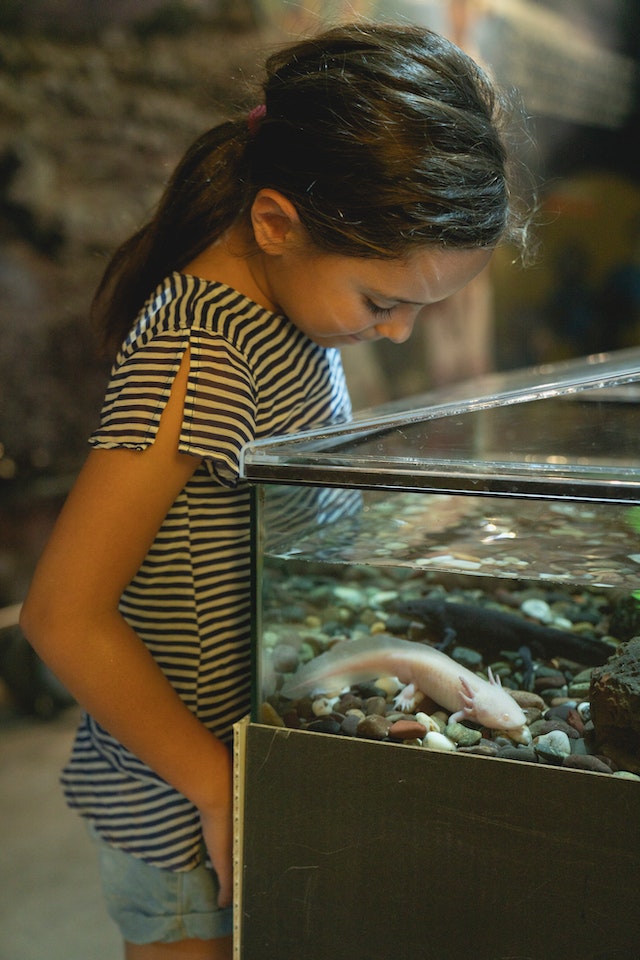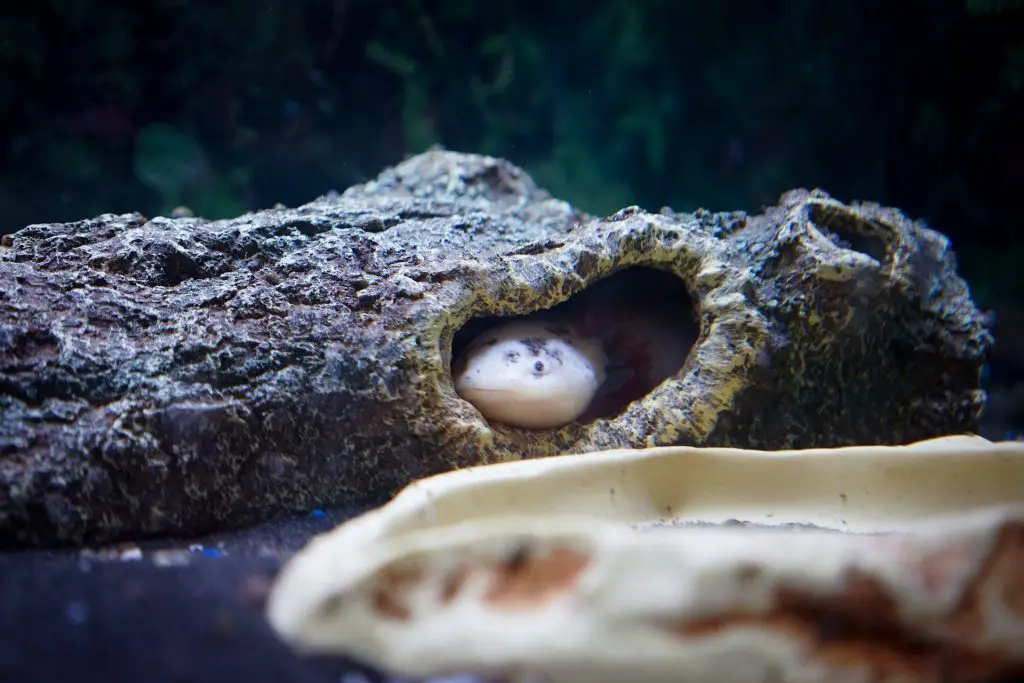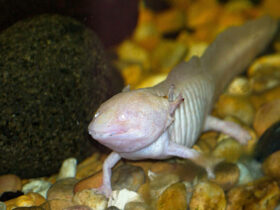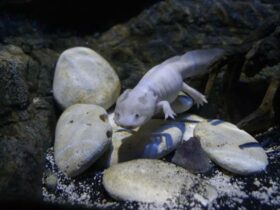
Contents
Are Axolotls Hard To Take Care Of? – Introduction

So you’re thinking about getting an axolotl as a pet, are you? These adorable amphibians with their permanent smiles and feathery gills are undeniably appealing. But don’t let those cute faces fool you – axolotls require some serious care and commitment. Before you run out and get one of these exotic pets on impulse, you need to understand what you’re really signing up for. Axolotls can live up to 15-20 years, so they’re not a short-term pet. They need a specialized habitat, strict water conditions, and a diet of live foods.
If you’re up for the challenge of keeping your axolotl healthy and happy for potentially two decades, they can make wonderfully engaging and rewarding pets. But don’t say I didn’t warn you – caring for these aquatic salamanders is not as simple as their playful personalities might lead you to believe! Are you ready to take the plunge into axolotl ownership?
AXOLOTL CARE GUIDE | Housing, Feeding, & Tank Mates | Ambystoma mexicanum:https://m.youtube.com/watch?v=hZzSbCCC3KM&t=9s&pp=ygUiQXJlIEF4b2xvdGxzIEhhcmQgVG8gVGFrZSBDYXJlIE9mPw%3D%3D
Are Axolotls Difficult to Care For?
Are axolotls hard to care for? Not really, if you provide what these adorable amphibians need. But they do require daily attention and commitment.
First, axolotls need a spacious aquarium, at least 20 gallons for one axolotl and 10 more gallons for each additional axolotl. They produce a lot of waste and need good filtration and water flow. Perform regular partial water changes of about 25% of the tank volume every week or two to keep conditions clean and your axolotls healthy.
Axolotls also require certain water conditions, like a temperature between 60 to 68 F, a pH between 6.5 to 8.0, and low levels of nitrates and nitrites. You’ll need to test the water frequently and be prepared to do water changes if conditions start to slip.
In terms of feeding, axolotls should be fed a diet of nutritious foods 2-3 times per day, like earthworms (a favorite), shrimp, krill, daphnia, and commercial axolotl pellets. Only offer as much food as your axolotl can eat in about 5 minutes at each feeding.
While axolotls don’t need to be handled often, you’ll still need to spot clean the tank and perform regular maintenance. Their lifespan can also exceed 15-20 years, so they’re a long-term commitment.
With the proper enclosure, diet, water conditions and care, axolotls can make interesting and rewarding pets. But don’t be fooled – they may look low-maintenance, but these aquatic salamanders actually require daily dedication. If you’re up for the responsibility, axolotls can be a joy to keep. But go into axolotl ownership with realistic expectations of the time and resources they need.
Housing Requirements: Size Matters
Axolotls may look like exotic pets, but don’t let their unusual appearance fool you. These salamanders actually have some very basic needs. To keep your axolotl happy and healthy, you’ll want to provide them a properly sized aquarium with a secure lid, clean water, and the right temperature.
An adult axolotl will need at least a 20-gallon long aquarium. Axolotls produce a lot of waste, so you’ll need a filter and will need to perform regular partial water changes of about 25% of the tank volume every week. Make sure any decorations in the tank don’t have small parts that could be choking hazards. Axolotls may try to eat anything that fits in their mouth!
Axolotls prefer their water cool, between 60 to 68°F. You’ll need an aquarium chiller and thermometer to monitor the temperature. Warmer water will stress out your axolotl and make them prone to disease.
Axolotls also appreciate places to hide, so provide some caves, plants, or other shelter. Make sure any plants are firmly anchored so they don’t uproot. Axolotls aren’t the most graceful swimmers and could get tangled!
Feed your axolotl a diet of earthworms, feeder fish, shrimp, and quality pelleted food. Axolotls need a balanced diet to stay healthy and grow properly. Never release any live food into the tank, as it could nip at your axolotl or pollute the water.
While axolotls may look low maintenance, they actually require daily attention. If you provide them a proper home, cool and clean water, shelter, and a healthy diet, your axolotl can live 10-15 years and bring you lots of enjoyment. The effort is well worth it for such a unique pet!
Water Conditions Axolotls Need
Axolotls may look like easy pets, but their water conditions require some attention to detail. These amphibians have complex needs, so their aquarium environment must be carefully controlled.
Water Temperature
Axolotls prefer cold water, so you’ll need equipment to keep the temperature in the proper range. Their water should be between 60 to 68 degrees Fahrenheit or 15 to 20 degrees Celsius. If the water gets too warm, your axolotl can become stressed and more prone to disease. You’ll want an aquarium chiller or cooling fans to prevent overheating, especially in hot summer weather.
Water pH Level
The pH level refers to how acidic or alkaline the water is. Axolotls thrive in water with a neutral to slightly alkaline pH between 7 and 8. You’ll need to test the pH regularly and make adjustments as needed using pH modifiers. If the pH gets too low or too high, it can harm your axolotl’s skin and gills. An ideal pH test kit will cover a range from at least 6 to 9 so you can closely monitor any changes.
Water Filtration
Axolotls produce a lot of waste and need powerful filtration to keep their water clean. Aim for a filter that can turn over at least twice the volume of your aquarium every hour. For example, a 20-gallon long aquarium would need a filter rated for at least 40 gallons per hour. In addition to a filter, you’ll need to perform regular partial water changes of about 25 percent of the tank volume every week to remove nitrates and other pollutants.
Substrate and Decorations
Axolotls can accidentally swallow loose gravel or small decorations, so their habitat should have either a bare glass bottom or very fine, soft sand. Any decorations added should be too large for the axolotl to fit in its mouth. Live or fake plants can make good hides and resting spots if securely anchored. Provide hiding spots, shady areas, and opportunities for your axolotl to explore!
Keeping your axolotl’s water conditions properly balanced may require daily monitoring and maintenance. But with the right equipment and care, you’ll be able to provide the ideal habitat for your amphibious friend. Their fascinating behaviors and alien appearance make the effort worthwhile!
Feeding Your Axolotl: What and How Often?
Feeding your axolotl properly is key to keeping it healthy and happy. Axolotls are carnivorous, so their diet should primarily consist of meaty foods. As juveniles, axolotls should be fed every day. Adults can be fed 2-3 times a week. Never overfeed your axolotl, as obesity and other health issues can result.
Diet
Axolotls will eat a variety of meaty foods like:
- Earthworms (red wigglers) – a staple of an axolotl’s diet. Gut-loaded worms provide protein and nutrients.
- Feeder fish (like goldfish and minnows) – offer feeder fish 2-3 times a week. Be very careful not to introduce any fish that may bite or injure the axolotl.
- Shrimp (like ghost shrimp) – shrimp also provide good nutrition but can be messy, so spot clean the tank after feeding.
- Commercial pelleted food – pelleted food can supplement an axolotl’s diet but should not replace live foods completely. Look for a pellet specifically for salamanders and newts.
Never feed your axolotl:
- Insects (like crickets, mealworms) – insects have little nutritional value and can bite or injure the axolotl.
- Wild-caught prey – which may contain parasites and pollutants.
- Dog/cat food – lacks proper nutrition and the wrong pH for axolotls.
Feeding Schedule
Young axolotls (less than 1 year) should be fed daily, while adults can be fed 2-3 times a week. For adults, a good rule of thumb is to feed your axolotl prey that is no larger than the space between its eyes. Remove any uneaten food from the tank within 2 hours to avoid pollution. It is normal for an axolotl to skip a meal from time to time. As long as your axolotl remains active and maintains a healthy weight, there is no need to worry.
By providing a nutritious diet, appropriate amounts of food, and a regular feeding schedule, your axolotl will thrive. Consistent care and feeding will lead to many happy, healthy years together!
Common Health Issues to Watch Out For
As with any pet, axolotls can face health issues if not properly cared for. Be on the lookout for these common problems to keep your axolotl happy and healthy:
Fungal infections
Axolotls have moist skin and live in an aquatic environment, so fungal infections can develop if conditions aren’t right. Look for white, cottony patches on the gills, limbs or tail. Perform regular water changes, provide good filtration, and the proper temperature range of 60-68 F. You can treat minor fungal infections with aquarium salt or antifungal medications from an exotic animal vet.
Parasitic infections
Another threat is parasitic worms or protozoa like planaria, nematodes or coccidia. Watch for symptoms like lethargy, loss of appetite, diarrhea or visible worms. Have a vet examine a stool sample to determine the parasite and proper treatment, which may include deworming medication, water changes and disinfecting the tank.
Impaction
Axolotls swallow gravel and small stones to help grind their food, but this can lead to impaction if the stones cause a blockage. Signs are loss of appetite, lethargy and trouble passing waste. Provide axolotl pellets and worms as a staple diet, and only use very large aquarium stones that cannot be swallowed. See an exotic vet immediately if you suspect impaction.
Injuries
As your axolotl grows, watch that it does not get injured on any sharp decorations or surfaces in the tank. Smooth, rounded stones, corners, filters and other equipment will help prevent injuries. Check your axolotl regularly for any cuts, abrasions or limb injuries and treat minor wounds with antifungal ointment and iodine. For serious injuries, see a vet.
By keeping a close eye on your axolotl and its environment, you’ll be able to address any health issues quickly and keep your unique pet happy for many years to come. Let me know if you have any other questions!
Conclusion
So there you have it – axolotls can make interesting and rewarding pets but they do require daily care and commitment. While their needs aren’t overly complicated, you’ll need to be diligent in monitoring the water conditions, feeding them properly, and providing opportunities for exercise and enrichment. If you go into axolotl ownership with realistic expectations about their needs, you’ll find they can be quite charming and personable. Just be sure to do plenty of research on the front end and have their habitat fully setup before bringing your axolotl home.
With the right dedication, you’ll have a happy, healthy axolotl and a new scaly friend for up to 15-20 years! Not too shabby for such an unusual and fascinating creature.
More Links:
What Do Axolotls Drink? – Staying Hydrated: https://adoptanim.com/what-do-axolotls-drink/
Is It OK To Touch Axolotl? A Guide to Handling Axolotls in ’23! :https://adoptanim.com/is-it-ok-to-touch-axolotl/





Leave a Reply